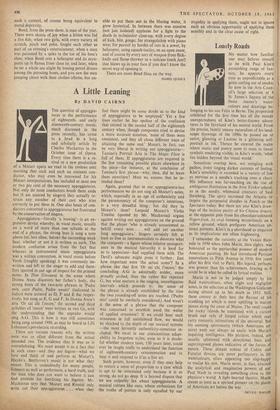Lonely Roads
No matter how familiar one may believe oneself to be with Paul Klee's astonishing range of fan- tasy, he appears every time as unpredictable as a genie curling out of smoke. So now in the Arts Coun- cil's large selection at 4 St. James's Square of the Swiss master's water- - colours and drawings be- longing to his son Felix in Berne. The proportion exhibited for the . first time has all the moody unexpectedness of Klee's better-known adven- tures in the fairyland of his mental world. From the precise, faintly uneasy naturalism of his land- scape drawings of the 1890s he passed on to satire, glancing at Lautrec in a glittering self- portrait in ink. Thence he entered the realm where music and poetry seem to meet in linear symbols rendering visible, in Klee's words, 'what lies hidden beyond the visual world.'
Sensations overlap here, wit mingling with pathos, irony tinging darker currents of feeling. Klee's sensibility is recorded in a variety of line as nervous as a needle's tracking over a chart. His influence was far-reaching on the rise of ambiguous illustration in the New Yorker school, as in the needly, whimsical creatures of Saul Steinberg. The spirit recrossed the Atlantic to inspire the purposeful doodles in Punch• or the Spectator today. But there are also Klee's draw- ings of the incisive purity of his Chinese beauty, at the opposite pole from his chocolate-coloured Negro-fruit, its oval looming mysteriously on a yellow ground, which prefigures American ab- stract portents. Klee's is a shorthand as exquisite ' as its implications are often frightening.
I remember the curiosity at the Venice Bien- nale in 1950 when John Marin, then eighty, was honoured as the patriarchal pioneer of modern American painting. He had introduced Parisian innovations to Fifth Avenue in 1910, five years after his first visit to Paris. His legend, perhaps, was greater than his achievement, bracing as it could be in what he called its lyrical realism.
Marin is not to be judged simply by his ,fluid watercolours, often slight and negligible notes, in the selection at the Waddington Galleries dating almost up to his death in 1953. Still, these convey at their best the flavour of his scudding art which is most uplifting in marine pieces along the coast of Maine. The swell round the rocky islands he translated with a cursive brush and veils of limpid colour which may carry romantic intimations of the universal. But his seeming spontaneity (which Americans ad- mire) went not always so easily with Marie's inquiring intelligence. His pictures, indeed, are usually splintered with directional lines and superimposed planes indicative of the forces of nature. These distant echoes of Cubist and Futurist devices are more perfunctory in his watercolours, often appearing too slap-happy to realise his aim. Marin never, in fact, attained the analytical and imaginative powers of our Paul Nash in revealing something close to the physicist's world. A light-hearted theorist, Marin stands at least as a spirited pioneer on the plains of American art before the war.
NEV ILL WALLIS


































 Previous page
Previous page